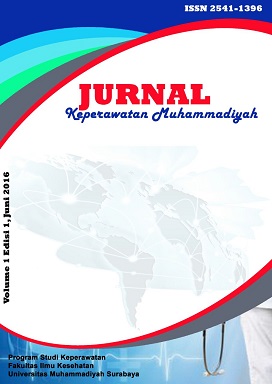PERBANDINGAN EFEKTIFITAS PEMBERIAN CAIRAN INFUS HANGAT TERHADAP KEJADIAN MENGGIGIL PADA PASIEN SECTIO CAESARIA DI KAMAR OPERASI
Abstrak
Objective: to analyzed Effectiveness Giving fluids to Infuse Warm on the incidence of shivering in patients Sectio Caesarea in Hospital Operating Room Dr. M. Soewandhie Surabaya.
Â
Methods: The design of this research True Experiment, pretest-posttest design with a control group (pretest-posttest with control group). Sampling method with probability sampling techniques, simple random sampling. Samples were some patients in the operating room SC Hospital Dr. M. Soewandhie Surabaya were 21 respondents in the control group (intravenous fluids at room temperature) and 21 respondents in the experimental group (warm IV fluids) on February 01 until February 15, 2014. Research tool: checklist, Fluid Warmer, tympani membrane thermometers and thermometer room. After the data were tabulated and processed SPSS for Windows version 16.0, Mann Whitney Test was analyzed.
Â
Results: The results of the study were respondents given intravenous fluids at room temperature 3 degrees most of the chills (intermittent tremors throughout the body) of 38.10%. While the respondents were given the warm intravenous fluids largely chills or 0 degrees by 95.24%. Analyzed by Mann Whitney test and the result Z = -4.219 and p = 0.000 (p ≤ 0.05) means that H1 is accepted and H ₒ rejected, meaning warm intravenous fluid administration was more effective than intravenous fluids at room temperature on the incidence of shivering in patients with SC.
Â
Conclusion: With warm intravenous fluids aims to maintain core body temperature, preventing hypothermia and shivering events by activating the mechanism of thermoregulation reflex and semi-reflex in humans, where the response may include a change of otonosomatik, endocrine and behavioral. With these results it is necessary to increase the amount of Fluid Warmer suit the patient's needs and existing equipment to use as possible.Unduhan
Diterbitkan
Terbitan
Bagian
Lisensi
- Penulis tetap memegang hak atas karyanya dan memberikan hak publikasi pertama kepada jurnal ini yang secara simultan karya tersebut dilisensikan di bawah:Â Creative Commons Attribution-ShareAlike 4.0 International (CC BY-SA 4.0)









